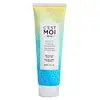Aveeno Calm + Restore Nourishing Oat Cleanser For Sensitive Skin Versus C’est Moi Gentle Foaming Cleansing Gel
What's inside
What's inside
 Key Ingredients
Key Ingredients

 Benefits
Benefits

 Concerns
Concerns

No concerns
 Ingredients Side-by-side
Ingredients Side-by-side

Water
Skin ConditioningGlycerin
HumectantButylene Glycol
HumectantAvena Sativa Kernel Flour
AbrasivePolysorbate 20
EmulsifyingPoloxamer 188
EmulsifyingZea Mays Starch
AbsorbentAcrylates/C10-30 Alkyl Acrylate Crosspolymer
Emulsion StabilisingCaprylyl Glycol
EmollientPhenoxyethanol
PreservativeDisodium EDTA
Ethylhexylglycerin
Skin ConditioningSodium Polyacrylate
AbsorbentSodium Hydroxide
BufferingChrysanthemum Parthenium Flower/Leaf/Stem Juice
AntioxidantSodium Hyaluronate
HumectantWater, Glycerin, Butylene Glycol, Avena Sativa Kernel Flour, Polysorbate 20, Poloxamer 188, Zea Mays Starch, Acrylates/C10-30 Alkyl Acrylate Crosspolymer, Caprylyl Glycol, Phenoxyethanol, Disodium EDTA, Ethylhexylglycerin, Sodium Polyacrylate, Sodium Hydroxide, Chrysanthemum Parthenium Flower/Leaf/Stem Juice, Sodium Hyaluronate
Water
Skin ConditioningGlycerin
HumectantSodium Cocoyl Glutamate
CleansingPropanediol
SolventXanthan Gum
EmulsifyingCaprylyl Glycol
EmollientCitric Acid
BufferingCoco-Glucoside
CleansingGlyceryl Oleate
EmollientCaprylhydroxamic Acid
Fragaria Vesca Fruit Extract
AstringentAloe Barbadensis Leaf Juice
Skin ConditioningPyrus Malus Fruit Extract
Skin ConditioningActinidia Chinensis Fruit Extract
EmollientCalendula Officinalis Flower Extract
MaskingSimmondsia Chinensis Seed Extract
AbrasiveWater, Glycerin, Sodium Cocoyl Glutamate, Propanediol, Xanthan Gum, Caprylyl Glycol, Citric Acid, Coco-Glucoside, Glyceryl Oleate, Caprylhydroxamic Acid, Fragaria Vesca Fruit Extract, Aloe Barbadensis Leaf Juice, Pyrus Malus Fruit Extract, Actinidia Chinensis Fruit Extract, Calendula Officinalis Flower Extract, Simmondsia Chinensis Seed Extract
 Reviews
Reviews

Ingredients Explained
These ingredients are found in both products.
Ingredients higher up in an ingredient list are typically present in a larger amount.
Caprylyl Glycol is a humectant and emollient, meaning it attracts and preserves moisture.
It is a common ingredient in many products, especially those designed to hydrate skin. The primary benefits are retaining moisture, skin softening, and promoting a healthy skin barrier.
Though Caprylyl Glycol is an alcohol derived from fatty acids, it is not the kind that can dry out skin.
This ingredient is also used as a preservative to extend the life of products. It has slight antimicrobial properties.
Learn more about Caprylyl GlycolGlycerin is already naturally found in your skin. It helps moisturize and protect your skin.
A study from 2016 found glycerin to be more effective as a humectant than AHAs and hyaluronic acid.
As a humectant, it helps the skin stay hydrated by pulling moisture to your skin. The low molecular weight of glycerin allows it to pull moisture into the deeper layers of your skin.
Hydrated skin improves your skin barrier; Your skin barrier helps protect against irritants and bacteria.
Glycerin has also been found to have antimicrobial and antiviral properties. Due to these properties, glycerin is often used in wound and burn treatments.
In cosmetics, glycerin is usually derived from plants such as soybean or palm. However, it can also be sourced from animals, such as tallow or animal fat.
This ingredient is organic, colorless, odorless, and non-toxic.
Glycerin is the name for this ingredient in American English. British English uses Glycerol/Glycerine.
Learn more about GlycerinWater. It's the most common cosmetic ingredient of all. You'll usually see it at the top of ingredient lists, meaning that it makes up the largest part of the product.
So why is it so popular? Water most often acts as a solvent - this means that it helps dissolve other ingredients into the formulation.
You'll also recognize water as that liquid we all need to stay alive. If you see this, drink a glass of water. Stay hydrated!
Learn more about Water